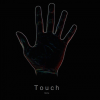“Toucher” is an interactive multimedia work of electronic literature by Serge Bourchardon, Kevin Carpentier, and Stéphanie Spenlé, which offers six options for exploration, each of which leads to a different scene that illustrates the ironies of an electronic piece of literature about touching that requires the use of a mouse. The work opens with the outline of a human hand, whose fingerprints lead to each of the subsequent scenes. The forms of touch offered include move, caress, hit, spread, blow, and brush, which all lead to a different scene with each of them having their own unique quirks that make us rethink about how we interact with the computer and with other people in a postmodern world that tends to focus on random events rather than face-to-face interaction between people.
We probably do not think much how much we interact with and learn about each other through touch, nor about what this says about our relationship with different people. The emotion of intimacy that is characteristic to the caress is shown in one of the scenes that is accessed through the index finger. As you trail the mouse across the screen, you follow the sounds of sighs as you trace out the shape of a young woman lying on her stomach. The image that is finally revealed appears in the screenshot below; it is pose that feels intimate. The image is all in black, which further emphasizes that this is an exercise about touch, since the visual picture does not appear until the very end. Touch, especially in the form of a caress, helps us form a picture, which becomes three-dimensional in our minds in regard to specific people because a caress is a way of tracing out people’s shapes. The scene does exactly the same thing except we are caressing this picture through a medium, the mouse. Because a caress is perceived to be intimate and a mouse to be impersonal it feels like they should clash, but they do not, because of the sound effects and the control we have over how much of the shape we fill in. The shape is black, which also reminds of how touching is a large part of the way blind people see. They caress one’s face to trace the outlines of it just as we trace the outline of the woman in the picture. When the picture is all traced out, you can see that it is very minimalist design, which differs from other fragments of the literary work. Tracing out this woman’s body brought all these thoughts to the surface as I considered how much of our perception of a person can change after a caress is used, particularly with people that we care about.
Another scene that we can access through using the mouse to touch ‘hit’ has a buzzing fly that leaves a trail of z’s which make the text it is flying on very difficult to read. The text in this section is a small passage from Aristotle on the subject of animals; to be able to read it, you must hit the fly by clicking the mouse on it. You can see that the fly is very difficult to hit, and that between the z’s left by the fly and the broken glass, the text becomes impossible to read. A buzzing fly is something that you are always trying to hit in real life, but can never quite get it. The fly above is the same way, and usually before you give up the screen looks like a reflection of your frustration. The same feeling is created by the real and the virtual fly, you have different mediums to try and hit it. This scene is completely different from the previous scene I described. Here, instead of caressing, the clicking of a mouse is equated to hitting, which is depicted by breaking the glass with the writing by Aristotle on it every time you miss hitting the fly. When you hit a fly, it is usually because it is buzzing around and annoying you. In complete opposition to the scene before, this is harsh with the breaking glass and the fly that you can almost never hit.
In this way, the scenes seems to be communicating that interacting though a mouse with a computer is not much different than the way we interact with things and other people in real life. Many works of literature portray technology as a cold and impersonal way of interacting with life, but this literary work seems to argue that it is not impersonal because the person operating the mouse is not impersonal. This piece electronic literature can be viewed for the most part on just your computer with a mouse and speakers. One or two of the sections require a webcam or a microphone. Loading it through eliterature.org is easy, you only need to click where it says begin. This work is also very subjective, my interpretations of the meaning behind this work could be completely different from someone else’s. The different scenes seem almost completely unrelated until you consider how each scene is another depiction touching through different mediums like music or drawing. “Toucher” is a fragmented work which offers a lot of insight into how we interact with computers and the world. With the growing number of people who use technology, this literary work is important in considering how we interact with technology.
Meghan Darcy was a student of Dr. Lisa Swanstrom for a course in Literary Theory taught at Florida Atlantic University in the Spring term of 2014.


